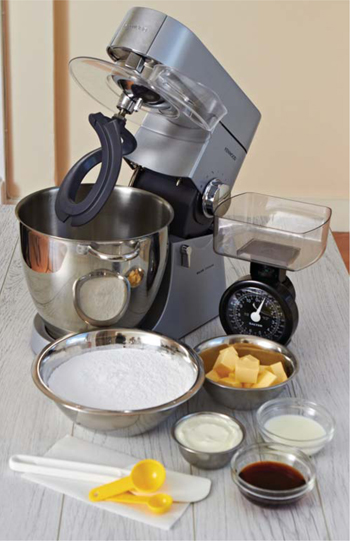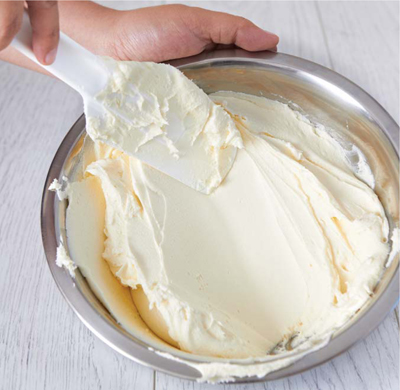
With this recipe, the one thing you should remember is never over-beat your buttercream. If you do it will become grainy and the edges of your petals are likely to ‘break’ when you pipe your flowers.
A hand-held mixer is not usually as powerful as a stand mixer, so if you are using a hand-held mixer, make sure you fold your mixture manually first until the ingredients are incorporated. This helps to avoid over-beating as well.
What is so good about our recipe is that a little less or more of a certain ingredient is fine. So if your buttercream is too stiff, add water or milk. If it is too thin, just add icing (confectioners’) sugar. Adjust it as you need to – all in moderation, of course. You may use your buttercream straight away to cover and decorate your cakes but we suggest you chill it in the fridge for about an hour for the best results.

This is a white solid fat made from vegetable oils, and is usually flavourless or at least bland. It plays a very important role in our recipe as it helps make our buttercream stable. It also allows the surface of the decorated cake to ‘crust’ so that it is not too sticky. And since it makes it stable, you do not need to add too much icing sugar to make a stiff consistency, thus your frosting has just the right sweetness.
Different brands of vegetable fat (shortening) have different consistencies. If the consistency of your shortening is somewhat medium-soft to slightly hard, like Trex, use 113g (4oz) in the recipe below. If it is soft and very spreadable, like Crisco, you will have to double the amount to 227g (8oz).
1. Beat the butter at medium speed until soft and pale (about one to two minutes). Some brands of butter are more yellow in colour, so to make it paler you can increase the beating time to about two to five minutes.
2. Add the vegetable fat (shortening) and beat for another 20 to 30 seconds or less. Make sure that it is well incorporated and that there are no lumps.
Important: As soon as you add anything to the butter, you must limit your beating time to 20–30 seconds or even less.
3. Add vanilla essence, or your flavour of choice and water, or milk, then beat at medium speed for about 10 to 20 seconds until well incorporated.
4. Slowly add the sifted icing (confectioners’) sugar and beat at medium speed for another 20 to 30 seconds or until everything is combined. You may want to fold the ingredients together manually before beating to avoid puffing clouds of sugar round your kitchen. Make sure you scrape the sides and bottom of your bowl, as well as the blade of your mixer, so you don’t miss any lumps of icing sugar.
5. Lastly, after scraping the bowl, beat again for about 20 to 30 seconds and do not over-mix. This yields a perfect piping consistency for buttercream.

You may add milk, but if you do you can only keep your buttercream for two to four days, as milk has a shorter shelf-life. If you use water, you will be able to keep it for longer – about five to ten days.
Flavoured buttercream will add character to your cake, and there are plenty of options to choose from: cocoa powder, fruit jam (jelly), peanut butter, squashed berries or even green tea to name a few. Just be mindful of consistency – make a batch of buttercream as described here then add your flavouring, you can add a little water or icing sugar at the end to adjust the stiffness. Beware of squashed berries or fruit, which may have a high water content and can make your buttercream very runny. If this is the case, you can omit the water or vanilla essence to reduce the liquid content.
If you make the basic buttercream recipe with the amounts given, one batch will yield approximately 1–1.1kg (2lb 71/2oz) of buttercream. This will be enough to cover the top, the sides and fill a 20cm (8in) round or square cake, or decorate about 20–30 cupcakes, depending on the design. This can be your guide to determine how much frosting you need to prepare. If you have any buttercream left over, just label it with the date you made it and store it in the fridge.
Keep your buttercream inside the refrigerator (chiller) and store it in an air-tight container or food storage bags. You can freeze it for up to a month, letting it defrost thoroughly at room temperature before use. Do not beat it again in a mixer, just mix it manually. But of course, nothing is better than fresh buttercream!